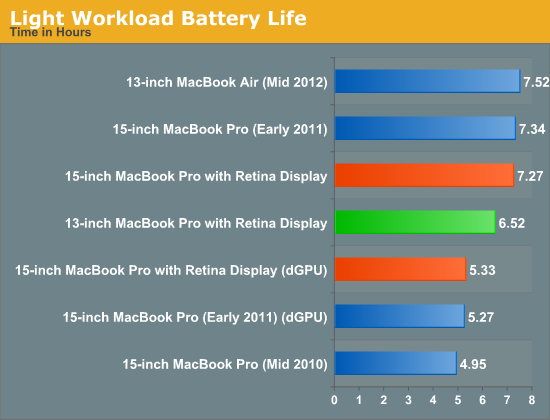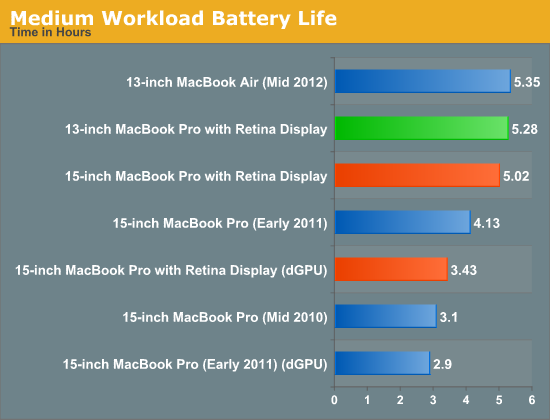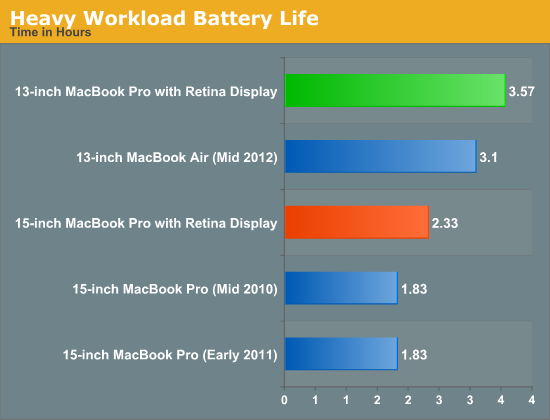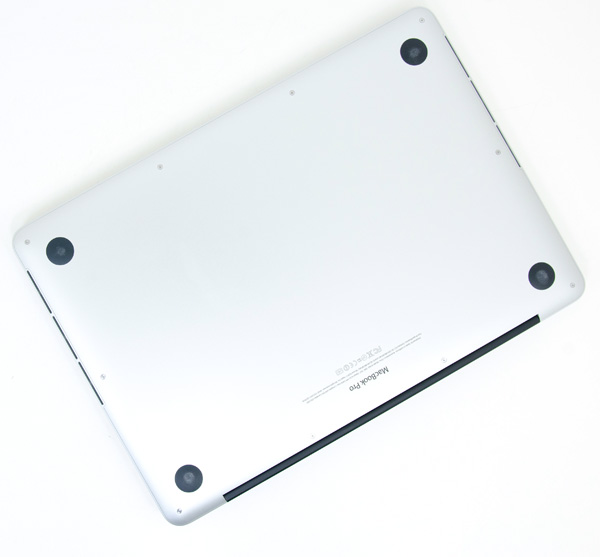13-inch Retina MacBook Pro Review (Late 2012)
by Anand Lal Shimpi on November 13, 2012 2:53 AM ESTBattery Life
The 13-inch rMBP features an integrated 74Wh, non-user-serviceable lithium polymer battery. The smaller chassis forced the use of a smaller battery compared to the 95Wh part used in the 15-inch rMBP. With a 22% reduction in battery capacity, the question is whether or not the drop in power consumption will keep battery life balanced between the two systems. CPU TDPs also go down by an identical 22% (45W down to 35W), but the comparison is more complex than that. The 15-inch rMBP has an on-board discrete GPU that, when active, can significantly impact battery life. Without the dGPU inside the system, the 13-inch rMBP does potentially have an advantage.
To quantify battery life, I turned to our updated OS X battery life suite that I introduced earlier this year. As always we have three individual tests, each simulating a different amount of load. All battery life tests were run with the display calibrated to 200 nits. The test descriptions are below:
The light and medium suites are inherently related - they use the same workload and simply vary the aggressiveness of that workload. The light test hits four different websites every minute, pausing for nearly the entire time to simulate reading time. Flash is enabled and present on three of the sites. The long pause time between page loads is what really makes this a light test. Web browsing may be the medium for the test but if all you're doing is typing, watching Twitter update and maybe lazily doing some other content consumption this is a good representation of the battery life you'll see. It's a great way of estimating battery life if you're going to be using your notebook as a glorified typewriter (likely a conservative estimate for that usage model).
The medium test hits the same webpages (Flash and all) but far more aggressively. Here there's less than 10 seconds of reading time before going onto the next page. It sounds like a small change but the impact on battery life is tremendous.
Both the light and medium tests are run in their default state with processor graphics enabled, as well as with the discrete GPU forced on. I run with the dGPU on as well because it's far too often that a single application open in the background will fire up the dGPU and contribute to draining your battery. The goal here is to deliver useful numbers after all.
The final test is very similar to our old heavy multitasking battery life tests, but with some updates. Here I'm downloading large files at a constant 1MB/s from a dedicated server, while playing back a looped 1080p H.264 movie (the Skyfall trailer) all while running the medium battery life test. The end result is a workload that gives you a good idea of what a heavy multitasking usage model will do in terms of battery life. I've found that OS X tends to fire up the dGPU anyway while running this workload so I saw no reason to run a separate set of numbers for processor and discrete graphics.

Our light workload doesn't do much to stress all four cores in the 15-inch rMBP, so that machine effectively behaves like a 13-inch rMBP with a bigger battery. The larger display (more pixels, more power hungry backlight) does consume a bit more power but the 15-inch rMBP manages to last 11% longer on a single charge compared to the 13-inch model. Turn the dGPU on however and the 13-inch rMBP easily outlasts its bigger brother.
Compare the 13-inch rMBP to the 13-inch MacBook Air and you see exactly why the Air isn't getting a Retina Display anytime soon. With only a 50Wh battery, the MacBook Air manages 15% better battery life than the 74Wh 13-inch rMBP. The MBA uses a much lower powered CPU, but I don't know how responsible that is for the difference in battery life here given the very light workload. If I had to guess, I'd say the reason for the difference here is the display and backlight power consumption. What may be more likely than a MacBook Air with Retina Display is some sort of MBA/Retina iPad convergence into some sort of a new device down the road.

Ratchet up the workload and the two rMBPs look very similar in battery life, with the 13-inch model holding onto a 5% advantage. The 13-inch MacBook Air also loses its battery life advantage here as well. Once again if you turn on the dGPU, the 15-inch rMBP blows through its battery much quicker.

In our heavy test the 13-inch rMBP sets a new record for our new suite, outlasting the 13-inch MBA by 15% (despite having a 48% larger battery). Worst case battery life is much better on the smaller rMBP compared to the 15-inch model thanks to its use of a dual-core processor with no discrete GPU. Performance obviously suffers, but if all you care about is battery life the 13-inch rMBP will do better on a single charge.











79 Comments
View All Comments
James5mith - Tuesday, November 13, 2012 - link
One of the biggest advances the Windows OS made was moving from a strictly CPU driven windows management interface, to a GPU accelerated one. (Vista, Win7, Win8)It stopped things like the classic "trail of artifact windows" you could do when your old WindowsXP and earlier machines were bogged down. Since the desktop was drawn by the CPU, it wouldn't refresh properly until some CPU cycles were freed up.
Seems Apple did not learn from the past, and is now doomed to repeat it.
Ryan Smith - Tuesday, November 13, 2012 - link
Actually Apple introduced GPU accelerated window composition with Quartz Extreme nearly 10 years ago, a few years ahead of Microsoft.However there are several layers to GPU acceleration. The earliest solutions could do window composition on the GPU, but the contents of the windows themselves were still generated by the CPU. Since then both MS and Apple have been moving more and more of the workload on to the GPU as it makes sense to do so. But no one is 100% offloaded, so the CPU still plays a part and consequently can still be a bottleneck.
michal1980 - Tuesday, November 13, 2012 - link
The bias is strongsolipsism - Saturday, November 17, 2012 - link
Yes, the bias is strong... in you.<ul><li><a href="http://www.anandtech.com/tag/windows-8>http://w...
cjs150 - Tuesday, November 13, 2012 - link
But not yet. One maybe two generations to go before perfect.1. One obvious use of this will be to watch movies on go (especially on long business trips) but once again Apple ignores 1080p resolution (if there someone at Apple who hates this resolution, because they try and ignore it in every device they produce)
2. Card reader is flaky - is it because of chassis flex or just a bad reader?
3. storage needs to be bigger, I gues next generation will be 256gb.
4. A bit extra horse power obviously needed, but probably not a lot.
The real question though is as tablets get better, is there any point in the 13" Mac?
xTRICKYxx - Tuesday, November 13, 2012 - link
What software do you use to test the framerates of the browser?Jorange - Tuesday, November 13, 2012 - link
$1700 and laggy UI. Come on Apple fans admit that you buy their products for the image, and for fear of being seen as gauche in the eyes of your vapid clique. The best Apple zealots are those whom purchase the things on credit, look how wealthy I am, whilst paying off the monthly installments:)boblozano - Tuesday, November 13, 2012 - link
This is the first review that I've read that captures the essence of this machine -- it is a machine of excellent balance, and in that balance lies it's real reason for being.Came from a mid-2011 mbair (1.8 i7, 256gb), and before that a mid-2009 mbp 15. Workload is a mix of writing, photo editing (lr, ps, etc.), and some video creation. Lots of travel. Went to the mbair after good friends with a heavy dev emphasis swore it was excellent. It was/is.
Considered the 15 rMBP since the price is effectively the same, and there is obviously more of just about everything. But size for travel and general mobility was a significant concern (the air allowed me to switch from a full-size backpack to a much smaller messenger bag).
The reason why I've settled on 13 as just about perfect for my present usage is simple: with the increasing number of full-screen apps, 13" is just about perfect for writing in a full screen, while 15 just feels overwrought. Even better, with retina the photo and video editing remains very usable.
With that as a background, the 13" rMBP was a real step up in everything that I liked about the air, with hardly any compromise (small bit of weight). Ended up with the 2.9 I7, 512gb. Everything I do is faster, better (though definitely not cheaper), and that screen just makes you smile when opening it up to work. It is good enough that I'm even going back to using the device open on a stand (trying the new twelve south height-adjustable stand) when docked.
Sure it would be nice to have 4 cores and a discrete gpu (particularly for rendering), but as of now there's no doubt it would have compromised mobility and/or battery life. About the only indisputable criticism is one of value, but such is life.
Undoubtedly (and always) there'll be something much better down the road, maybe even only a year from now. Good. But as of today, this is the best computing device I've ever used on a daily basis.
caleblloyd - Tuesday, November 13, 2012 - link
Anand - the Primary Storage for the 13in MBA that you have listed on the table on the first page should be 128GB.repoman27 - Tuesday, November 13, 2012 - link
"In reality USB 3.0 is good for about 400 - 500MB/s (3.2Gbps - 4.0Gbps)..."The actual reality is that USB 3.0 provides a physical layer gross bit rate of 5 Gbit/s, and a physical layer net bit rate of 4 Gbit/s due to 8b/10b encoding. The net bit rate delivered to the application layer is unlikely to ever exceed 80% of that, or 400 MB/s, in the real world. Even using UASP, which clearly looks to be the case in these tests, I've never seen peak SuperSpeed USB transfer rates much in excess of 350 MB/s. USB 3.0 is good for 300 - 350 MB/s with the hardware shipping at this point, although we may see the upper bound approach 400 MB/s in the future.
"This is Intel's most capable Thunderbolt SKU as it takes four PCIe 2.0 lanes combined with DisplayPort and muxes them into four Thunderbolt channels (2 up/2 down) with two DP outputs."
This sentence has some problems as well. The DSL3510L has connections on the back end for 4 PCIe 2.0 lanes, 2 DisplayPort 1.1a sources and 1 DisplayPort 1.1a sink. On the front side it has four 10 Gbit/s, full-duplex Thunderbolt channels, 2 per port (i.e. 2 up/2 down per port or 4 up/4 down per controller). Each port can also operate in legacy DisplayPort signaling mode when a DisplayPort device is connected directly.
On another note, it's frustrating that Apple failed again at the SDXC card reader, and it appears to be a mechanical issue once again. iFixit's teardown photos seem to have omitted it, but if Apple used the same controller as in the 15-inch MBPR, then it's a Broadcom controller that supports SD 3.0 features such as SDXC and UHS-I paired with a PCIe 1.1 x1 back end. This should make it far more capable than a USB 2.0 based solution, but no, instead they made it useless because half the time it doesn't read a card at all when inserted.